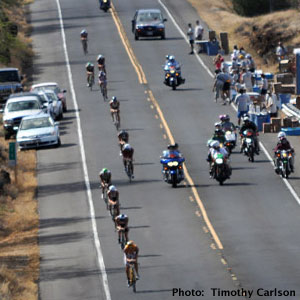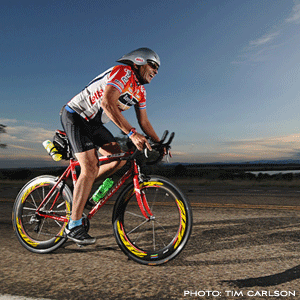
Over the Spring I’ve written twice about what I think are the most important elements of triathlon training: consistency; and maintaining a critical mass of work (links at the bottom of the page). My thesis is that a regular, dependable regimen of mileage subordinates any attempt at quality work, if the price paid for this quality is days off and missed sessions. If you train 12 hours a week at any speed, you’ll be fitter, healthier, and faster than if you train 5 hours at high speed.
Better yet is if your work is symmetrical across disciplines. Well known by now is our equivalency scoring: 1 point earned per mile of cycling; per quarter mile of running; and per 100 meters of swimming. So, then, 80 miles of cycling, 20 miles of running, and 8000 meters of swimming is a very solid and entirely symmetrical age-group week (not that all your weeks should be symmetrical, but all your months probably should be).
That symmetrical week might take about 12 hours to transact (5 hours of cycling, 3 of running, and 4 of swimming).
Were I your coach—and if I was confident in your fitness, technical ability, years in the sport, and available training time—I might endeavor to increase your training incrementally until you reliably achieved these totals. These 240 “aerobic points” per week might be appropriate for you, or it might be 300, or it might be 180 or 140. Your speed, fitness level, time commitment to triathlon, weight relative to your ideal weight, and tenure in the sport, all accrue to determine this. How do you know what your optimal weekly mileage is for the 2009 season? If you increase your mileage incrementally without increasing your heartrate and intensity, you’ll bump up against a bit of a wall after two or three months. Your body will cease its ability to absorb the work, and you’ll need days off to recover. Your sustainable weekly total is apparently something slightly below this.
And all this is against the backdrop of the occasional time off, which you need as a matter of course. Not a bad model is one off day out of 7, one easy week out of four, and one easy (or off) month out of every five or six. One might quarrel with my attachment of rest periods to time increments unrelated to the body’s training rhythms, and that’s fine. The point is the need for occasional rest, and if a day off out of every five, or ten, suits you better than one out of seven, I’ll not quarrel with that.
None of the above, you’ll notice, leaves any room for speedwork. You’ll be a better, faster, fitter, healther athlete if you find a sustainable, and symmetric, amount of work you can perform. Can you move from a 600-point month to an 800-point month? From 800 points to 1000 points? Can you do this while keeping the lawn mowed, your spouse happy, and with your sense of humor intact? If so, then maybe you’re ready for some speed.
Before you lace up your track spikes, though, let’s talk about this for a moment. If you ascribe to the sort of themes contained in the paragraphs above, your job prior to any speed at all is just doing the distance; doing the work—which you’ll perform almost entirely considerably slower than race pace (except for the swim, we’ll talk about this special case in a minute).
I’m being facetious when I quip about track spikes, because many folks falsely equate speedwork with faster-than-race-pace work. I don’t see it that way. I think speedwork, in the context of this next step in your training, is simply doing your training at a faster pace than you’ve been going up ‘til now. In fact, let me tell you what speed is for me, in its earliest-season form: the terrain is flatter; and I’m now wearing a watch.
In the early season, before I’m interested in speed and while I’m just trying to string together day after day of healthy work, I don’t wear a watch. Why? The same reason a recovering alcoholic stays away from bars: because I’m addicted to performance metrics, and in the early season I can’t be trusted with that sort of feedback.
So you see that when I wear the watch, especially on flatter terrain where I have established PRs, I’m now thinking about my pace. But I’m still not running or riding very fast—not in the beginning. Certainly nothing approaching race pace. Yet, this is still speedwork for me. My once- or twice-per week tempo runs are fairly slow. But instead of 10, 11, or 12 minute-per-mile trail runs over mountainous terrain, I’m now running 8-minute miles on flat terrain. And, truth be told, that is not an easy sort of run (not in the beginning of the speedwork season).

Likewise, speedwork on the bike entails timed rides on 15 to 30 mile courses where the terrain is flatter. And there is one additional difference on the bike: up ‘til now, all my early season riding has been on my road race bike. Now, for these tempo rides, I’ve transitioned over to my tri bike. Why? Because, if you own two bikes, the road bike is generally for easy rides, the tri bike is for harder efforts, and now I’m ready for harder efforts.
As the weeks progress, these 2 or 3 timed sessions per week will get faster and faster, both on the run and on the bike. You won’t believe how much faster you’ll get, and how quick that speed will come, just doing these tempo workouts. But for the first month or so they’ll still be slower than race pace.
Why am I transitioning to speedwork so incrementally? Because throughout this speedwork phase I’ll still endeavor to keep my “point” totals about where they have been. If I’ve been holding, say, 200 aerobic points per week during my build phase, then I won’t want to drop this weekly total once I’ve started speedwork (except for my once-per-month easy week). I’ll try to add speed incrementally, such that the day after my speed session I’ll still wake up fresh and ready to tackle the day’s workouts.
You will find that there is a practical limit to how many land-based speed sessions you can handle in a week. The younger you are, the more you can handle. That established, 2 to 3 is a pretty good number. If you can’t handle this many, maybe your speed sessions are just too hard. As a triathlete, you have to be careful. You’ll do more workouts than your typical single-sport analog. Best to throttle back on the ball-buster workouts, and just make sure you’re able to return fresh day after day.
Let’s talk swimming for a second because, while the approach is the same, the mechanics are not. Imagine what it must be like to train a “gaited” horse. If you’ve ever seen a Tennessee Walker or a Paso Fino taken through his paces, you know what I’m talking about. Otherwise, imagine a harness racer (a trotter or a pacer) pulling a sulky (the “cart” the horse pulls). First, you have to train the horse to maintain perfect form—to maintain this rather unnatural gait throughout the workout. If you train the horse mile after mile, even after he loses his ability to maintain that gait, then you simply reinforce bad mechanics.
For this reason, if you take time off from swimming each Winter, then during your return I don’t advocate long slow swims, if you can’t maintain proper form during the swim. Me, I’ll spend several weeks doing sets of 50s and 75s, and I might not do a set of 100s for a month or so after restarting swimming in the Spring. Why? Because proper swim technique is not natural. It’s not intuitive. It’s like teaching a gaited horse how to run. I can’t hold proper technique for very long early in the year.
This doesn’t mean I’m doing speedwork, per se, when I start swimming. It’s just that I literally can’t hold good form in the water for more than 50 yards when I first return to the pool after several months worth of layoff. As I write this, I’ve been in the pool for two months after my Winter layoff, and my longest sustained swim so far this year has been 500 yards.
But that paradigm doesn’t track with running and cycling. You can perform these land-based events at a slow pace, maintaining proper technique at a slower pace. Accordingly, I like the idea of slow, easy-on-the-brain, rides and runs, gradually increasing the distance, for months before very gingerly injecting speed into the mix. Even then, “speed” isn’t very speedy, not for some weeks at least.
What about running repeat intervals on a track? Or fartlek runs? Or performing cycling intervals on a trainer? Or doing repeat hills on your bike? Theoretically, I’m not against any of this. But, these are very sophisticated workouts, and they won’t provide (most of) you any benefit that tempo runs and rides—performed slowly at first and only incrementally faster, and probably not above race pace—won’t provide for you. The trick is to get faster afoot, and on the bike, without sabotaging tomorrow’s workout. For this reason, categorize speedwork with caffeine, tequila and the Playboy Channel: it may be legal; it may be allowable; and you may be able to make a case for it. But use with care: before you know it it’s addictive and ultimately destructive.


